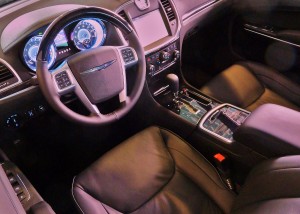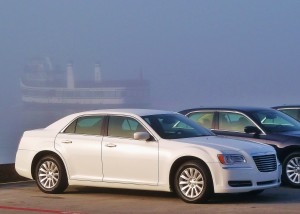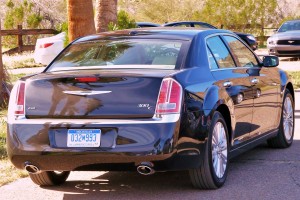Chrysler aims high, 300 hits target
By John Gilbert
There were three distinct reasons why I was ready to be impressed by the 2011 Chrysler 300.
First, when the 300 was resurrected for a reintroduction five years ago, the look was abrupt and bold, and bricklike. I’m all for abrupt and bold styling, but I am definitely not a fan of designing vehicles to resemble a brick. The Chrysler 300 turned out to be North American Car of the Year, proving that Chrysler was wise in its polarizing design, because love/hate polarity works if enough of the “love” side buys your car. Now that the Chrysler 300 is not only due for replacement, but is representing a microcosm of Chrysler corporation itself in its battle for survival, I was hoping the new 300 would improve on the outgoing brick…I mean, car.
Secondly, a number of cynics in the media seem to be ready to let Chrysler fail, after General Motors and Chrysler both required government aid to get to bankruptcy procedures that avoided going out of business. While most seem to be pulling for GM, it seems that the cynics among auto journalists have no sense of pulling for the underdog as Chrysler battles to reach sea-level.
The third reason is more self-gratifying, perhaps, but the 300’s introduction was being held in San Diego, where folks were grumbling about the January temperature dipping to something like 67 degrees. That was during a January week when the temperature in Minnesota was somewhere between 15-25 degrees below zero. I feel fully invigorated when it gets extremely cold, but this has been a winter where I’ve learned that there can be limits to necessary invigoration, and then it’s nice to get away to somewhere like…San Diego. So it would be a nicer trip if the Chrysler 300 was good, too.
The new 300 will be a worthy flagship for the rising prospects of Chrysler. It is just now making its way to dealerships, and once it shows up, consumers can climb in and around it in a setting more realistic than the Detroit or Chicago auto shows, and find out that the new car is a significant step forward — for the car, and the corporation.
Fiat is taking over Chrysler, and the merger of those corporate minds is perfectly timed. The Italian flair for design and style is notable, but Fiat officials also seem genuinely impressed with Chrysler’s history and potential in the marketplace. Chrysler designers and engineers, meanwhile, have been focused on impressing their new owners. When we met a carefully aligned group of 300s parked on a pier in San Diego’s harbor, Olivier Francois, the new president and CEO of Chrysler Brand’s segment, was about to address the assembled media members when the microphone wouldn’t work.
“We’ve put our money in the car,” Francois said, “so there is no money for microphones.”
A lively wit is a key ingredient for a successful automobile executive these days, and Francois was sharp. “We wanted to prove to the world that you don’t have to cross the ocean to get a great car from Chrysler,” Olivier said. “We think the 300 will reignite the full-size sedan segment. It’s not easy to follow the most-decorated sedan ever, but we’ve bench-marked the best sedans in the world for quality, materials, fit and finish, and performance, and we think the new 300 is not only beautiful, but it will perform.”
By setting up vehicles as the best in various categories as bench-marks, Chrysler learned its own limits and capabilities. A car that is best in some areas might be lacking in others, and while Chrysler isn’t claiming to have beaten all of them, by making the new 300 competitive with all of them in all categories makes the new 300 better than most in combining the assets into one vehicle.
“We think the 300 is the safest car in the American industry, and we have new engines, like our Pentastar V6, which is the latest and most powerful and fuel-efficient V6, and we have an 8-speed transmission coming. We deliver something the customer didn’t expect. But it’s not what you pay for, it’s what you deserve.”
The new 300 maintains some connection with the popular and outgoing 300, but where the previous car had a large and almost vertical grille, the new one is laid back, gently, with seven horizontal blades replacing the previous grillwork. It retains the basic short-overhang, but the rounded off grille slopes back and blends into the hood, and the lights are contoured into the corners more smoothly, while the windshield is raked back 3 inches more than its predecessor. Same with the rear design, which is much less square and more contemporary. Definitely retained is the high beltline, which give the car a formal look from the side.
Chief designer Brandon Faurote explained that he redid the pillars and all the trim around the windows, narrowed the gaps between all sheet metal panels, and while paying strict attention to reducing wind and noise issues, the design team paid great attention to the tiniest details. The headlights are very neat, and the clear outer taillight lens houses LED lights. Inside, the clock that was round in the center of the dash stack is now shaped to mimic the shape of the grille.
Driving the car is enjoyable, because the 300 rides on a new platform, with new suspension, which keeps the car stable even in tight turns, and gives it a definite European road-car feel. From a performance standpoint, the base 3.6-liter V6 and the optional 5.7-liter Hemi V8 both fulfill their assigned tasks with brisk potency. Performance and handling are the perfect way to display the 300’s new technology, but Chrysler designers and engineers have focused on providing equipment and performance worthy of the best bench-marked competitors and offer those features even from the base model 300, which helps the 300 beat its competitors price for price at every level.
The base car starts at $27,995, and we test-drove one of those. The 3.6 has dual overhead camshafts and variable valve-timing, and it delivers 292 horsepower at 6,350 RPMs, and 260 foot-pounds of torque at 4,800 RPMs, with the torque spreading 90 percent of its peak foot-pounds out over a range from 1,800 to 6,350, on regular fuel. The base car has considerable equipment, including keyless entry and ignition, UConnect system connectivity, the largest touch-screen in the segment, with redundant controls on the well-shaped, and impressively sized steering wheel.
That 3.6 engine is new, and replaces a variety of outgoing, and outmoded, V6 engines from Chrysler, including the previous base 2.7 and the previous upgrade 3.5. It is also available on the Limited model, which starts with a base price of $31,995. The Limited adds heated front seats, a rear camera, upgraded audio, a panoramic sunroof that is by far the largest in the class, and an upgraded interior with real wood appliques.
The base car and the Limited, as well as the 300C, which has a base price of $38,995, all have rear drive with their front engines, but Chrysler hasn’t completely abandoned those of us who find winter driving often overshadows the performance intentions of RWD. The 300C is offered in an all-wheel-drive version, with the upgraded 5.7-liter Hemi V8. That engine puts out 363 horsepower and 394 foot-pounds of torque, more than enough to drive all four wheels and put the 300’s performance up there with the best of world-class performance sedans. Along with larger wheels and tires, the 300C takes the Limited equipment and adds standard heated and cooled front seats, heated rear seats, the 5.7 Hemi engine, a navigation system, and Sirius satellite equipment.
We also had a chance to push a 300C AWD through the mountainous areas just east of San Diego, and it tracked well and truly around the tightest turns, retaining a balanced stance all the way. Not to be overlooked, Chrysler’s attention to reworking the interior includes all new seats, with different bolstering in the backrest and even in the outer edges of the seat cushion, to improve support.
One interesting point came up, because one of the comparisons Chrysler designers made was to the Lexus LS electro-luminescent instrumentation. On Chrysler’s speedometer and tachometer, there are very formal, but very small, numbers, with large, eye-catching rectangles of light outlining each numeral. I mentioned that I, personally, would prefer larger numerals with either smaller outer marks or no outer marks at all — just let the numerals be the eye-catcher. Tony Brenders, the director of engineering quality, was riding with us, and explained how thoroughly his design team had worked before deciding on the style of the instruments. Stubbornly, I maintained that when a driver glances down at the speedometer, he should be able to discern in an instant that the needle is pointing at 65, without being distracted by some flashy rectangle of electronic light.
Brenders said he would note my opinion, but regardless, we were mostly entranced by his views of the changeover to working with Fiat management. “Fiat has been great to work with,” said Brenders. “A lot of things have changed. Before, the design studio might say, ‘We want it like this,’ and the engineers might say, ‘We can’t do this.’ But now we have a meeting every day to discuss what we need to get the job done.”
For years, the top-level administrators felt the friction. Brenders recalled that “Somebody was responsible for design, and I was responsible for testing.” And sometimes, what had been designed and built might not work out so well when tested, leading to numerous problems. The difference now, Brenders said, is that representatives from all factions involved meet and discuss and work out plans that are coordinated.

Plush leather seats, revised instruments, new steering wheel make new 300 a luxurious place to ride.
“The guys were all doing the best at their specific jobs, but now everyone is supportive of everyone else. You have to own your own problems, and you can’t just say, ‘They won’t let me do this…’ Everyone is supportive and absolutley focused to help get problems solved.”
“When we first came out of the bankruptcy, we realized we had to get the Grand Cherokee finished,” said Brenders. “When we started, we had the old car mentality, where somebody would say, ‘How did this happen?’ while looking for the enemy. There were conflicts among engineers, manufacturing, purchasing, quality, logistics, everything, but we evolved during the first 6-8 months after bankruptcy, and we changed from an attitude of ‘How did we get here?’ to more like ‘How can we get this done?’ We now realize the ‘enemy’ is not in our building; it’s Honda, or Toyota…”
Brenders recalled that not long ago, Chrysler was trying to get by building cars that now, in retrospect, were just adequate. Various projects would be carried through from start to finish, with hassles and internal disagreements from various groups. “We would build almost-good-enough cars,” Brenders said, “but somebody would say, ‘How can you prove to me that we should spend this money?’ That made it tough, because you can’t prove a negative. Now we have the voice of the customer, not the voice of the executive, suggesting we make some adjustment.
“If Lexus has the best instrument electronics, ours is pretty good now. Somebody can say that Lexus has more advanced electronics in their dash, we can say that we’ve got a leather dashboard.”
OK, I’ll concede that the very classy leather surface on the dashboard trumps my trivial pursuit of the speedometer light show. The larger point is, by striving to meet all if its objectives, the Chrysler 300 is a strong competitor to the best cars in the full-size marketplace, at a comparative bargain price.
Comments
Tell me what you're thinking...
and oh, if you want a pic to show with your comment, go get a gravatar!





 John Gilbert is a lifetime Minnesotan and career journalist, specializing in cars and sports during and since spending 30 years at the Minneapolis Tribune, now the Star Tribune. More recently, he has continued translating the high-tech world of autos and sharing his passionate insights as a freelance writer/photographer/broadcaster. A member of the prestigious North American Car and Truck of the Year jury since 1993. John can be heard Monday-Friday from 9-11am on 610 KDAL(www.kdal610.com) on the "John Gilbert Show," and writes a column in the Duluth Reader.
John Gilbert is a lifetime Minnesotan and career journalist, specializing in cars and sports during and since spending 30 years at the Minneapolis Tribune, now the Star Tribune. More recently, he has continued translating the high-tech world of autos and sharing his passionate insights as a freelance writer/photographer/broadcaster. A member of the prestigious North American Car and Truck of the Year jury since 1993. John can be heard Monday-Friday from 9-11am on 610 KDAL(www.kdal610.com) on the "John Gilbert Show," and writes a column in the Duluth Reader.